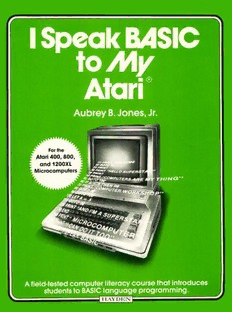
I speak BASIC to my Atari PDF
Preview I speak BASIC to my Atari
I Speak BASIC to My Atari® Aubrey B. Jones, Jr. [IJ HAYDEN BOOK COMPANY, INC. Rochelle Park, New Jersey To Alyce, Aubrey III, and Adrienne Acquisitions Editor: GARY MARKMAN Production Editor: RONNIE GROFF Production Assistant: LORI WILLIAMS Art Director: JIM BERNARD Compositor: VAN GROUW COMPOSITION CO., INC. Printed and bound by: THE MURRAY PRINTING COMPANY Atari is a trademark of Atari, Inc., and is not affiliated with Hayden Book Co., Inc. Copyright © 1983 by HAYDEN BOOK COMPANY, INC. All rights reserved. No part of this book may be reprinted, or reproduced, or utilized in any form or by any electronic, mechanical, or other means, now known or hereafter invented, including photocopying and recording, or in any information storage and retrieval system, without permission in writing from the Publisher. Printed in the United States of America 2 345 6 7 8 9 PRINTING 83 84 85 86 87 88 89 90 91 YEAR Contents Part 1 The Hardware (Or The "Boxes") ................. ...... 1 Objectives; Typical Data Processing Operation; Basic Parts of a Computer; Summary; Practice 1 Part 2 The Software ("The Program") ...... . . . . . . . . .. 17 Objectives; How Humans Talk to Computers; A BASIC Program; Atari Keyboards; Atari Power-Up Rules; Summary; Practice 2 Part 3 Your First Computer Program ... ... ........... .. . 38 Objectives; Writing Your First Computer Program, Ex ecuting Your Program; Expanding Your Program; List- ing Your Program; Ending Your Program; Summary; Practices 3, 4, 5 Part 4 More Programming Tools .... ... ... .... .............. 58 Objectives; Mathematical Operations; Programming Mathematical Operations; A BASIC Mathematical Pro gram-Area of a Rectangle; Print Zones; Practices 6, 7 Part 5 Scientific Notation ........ .......... ... .... .. ...... . 79 Objectives: Scientific Notation: Review and Feedback; Practice 8 Part 6 Relational Operators and IF-THEN/GOTO Statements .. 86 Objectives; Relational Operators; Using IF-THEN State- ments (Conditional Branching); Using GOTO State- ments (Unconditional Branching); Practices 9, 10 Part 7 Input Statements ......... ..................... 99 Objectives; Input Statements: Area of Rectangle Prob- lem Revisited (Using Input Statements); String Vari- ables; Practices 11, 12, 13 Part 8 Using the Calculator Mode and Sizing Memory. . . . . . .. 112 Objectives; Bit vs. Byte; How Much Memory Is Used in BASIC Programs: Summary; Practice 14 Part 9 Using the Cassette Recorder and the Disk Drive ...... 121 Objectives; The Cassette Recorder and the Disk Drive as Input/Output Devices; Practices 15, 16, 17 Part 10 Using FOR-NEXT-STEP Statements ... ......... ..... 130 Objectives: FOR-NEXT Statements and Loops; Com parison of GOTO, IF-THEN, and FOR-NEXT Program Loops; Loop Flowcharts; Timer Loops; Practices 18. 19 Part 11 Reading Data. . . . . . . . . . . . . . . . . . . . . . . . . . . . . . . . . . . . .. 146 Objectives: READ-DATA Statements; Restore Func- tion; Practice 20 Part 12 Video Display Graphics. . . . . . . . . . . . . . . . . . . . . . . . . . . .. 160 Objectives; Text and Graphic Commands: COLOR, GRAPHICS, PLOT, POSITION, SOUND, STICK, DRAWTO; Practice 21 Part 13 A~~ ... . . ...... ... . ..... .... .. ... ..... .. 1~ Objectives: One-Dimensional Arrays: Two-Dimensional Arrays: DIM Statement: Summary: Practices 22. 23 Part 14 INT(X), ABS(X), and RND(X) Functions .... . . . . . .. 197 Objectives: INT(X) Function: ABS(X) Function: RND(X) Function: Summary: Practices 24. 25 Part 15 Subroutines. . . . . . . . . . . . . . . . . . . . .. 211 Objectives: Subroutines: ON-GOTO: ON-GOSUB Summary: Practices 26, 27 Extra Practices ...... .. .............. ........ ...... 227 PART 1 The Hardware (Or The "Boxes") What You Will Learn 1. That the computer is a valuable tool that can solve problems, print words, draw pictures, store information, retrieve information, compare information, play games, and do many other things to help you in everyday life. 2. That people control computers and that computers cannot think (despite what you might have heard). 3. To identify and explain the basic parts of a computer and relate them to a "box diagram" of a general purpose computer. 4. To identify and explain the function of the basic parts of an Atari microcomputer. 5. To define and explain the terms hardware, software, microcomputer, micro processor, RAM, ROM, processor, input unit, output unit, memory, and binary. 6. That computers are simple and easy to use; and above all that computers are fun! 1 Welcome to the World of Computers! People Control Computers! Computers Can't Think! 2 Typical Data Processing Operation "Box" Diagram ·1· I ... _e .IN.P.U.T_. .. ·.I_.e.O.U.T.P.U.T_. . I 1 PROCESSING Examples of Data Processing Operation INPUT PROCESSING OUTPUT (CALCULATE) , .-- --.. ... 1. NUMBER HR WORKED (40 hr) ~ 40hr X 3.00/hr PAY TO XXX-X- .... = -", $120 2. RATE/HR _ ,. $120 ~ ($3.00/HR) ~ PAYCHECK INPUT PROCESSING OUTPUT (CALCULATE) 1. TOTAL NUMBER OF ST UDENTS ", 1. TOTAL ALL GRADES IN CLASS ~ 2. TOTAL ALL STUDENTS -,. AVG 3. TOTAL GRADES GRADE 2. GRADES FOR EACH .... TOTAL STUDENTS STUDENT 3 BOX Diagram Showing Basic Parts of a Computer • STORAGE UNIT - - .-. • INPUT • PROCESSOR • OUTPUT UNIT UNIT UNIT 4
